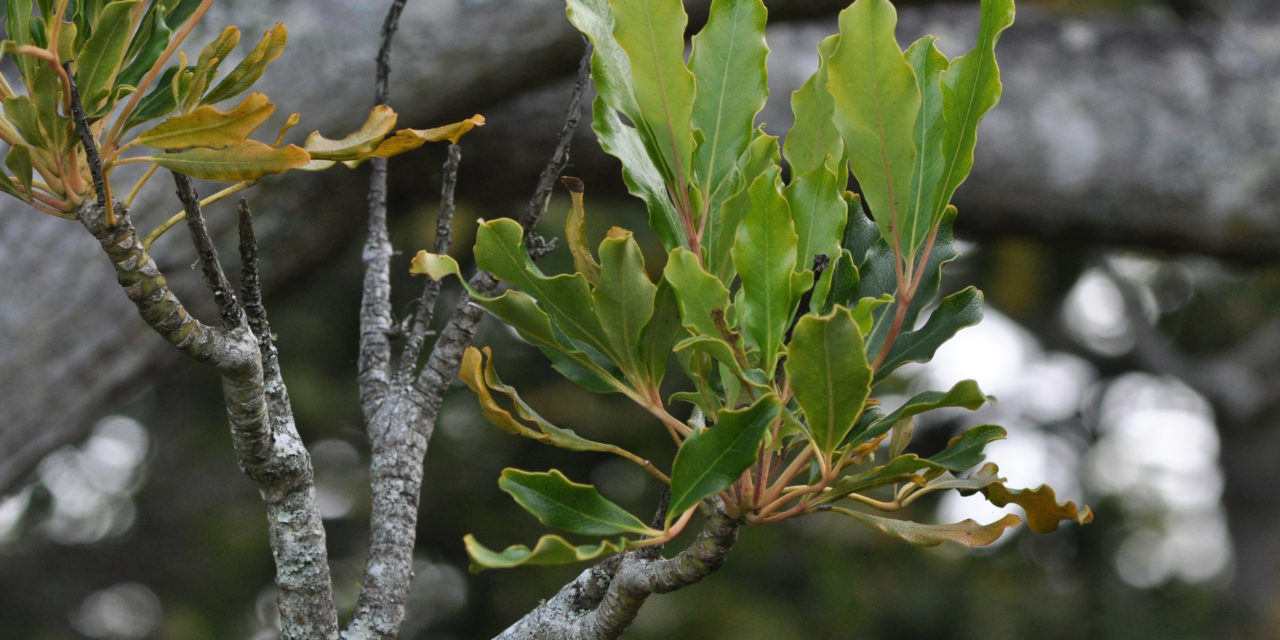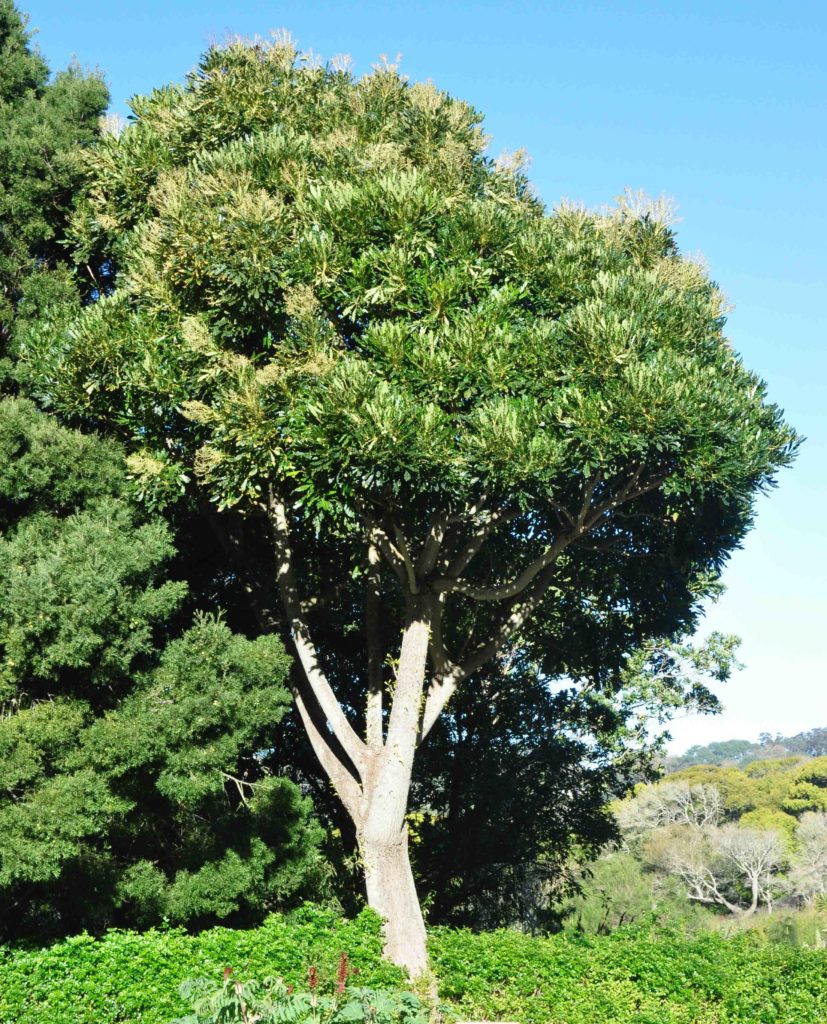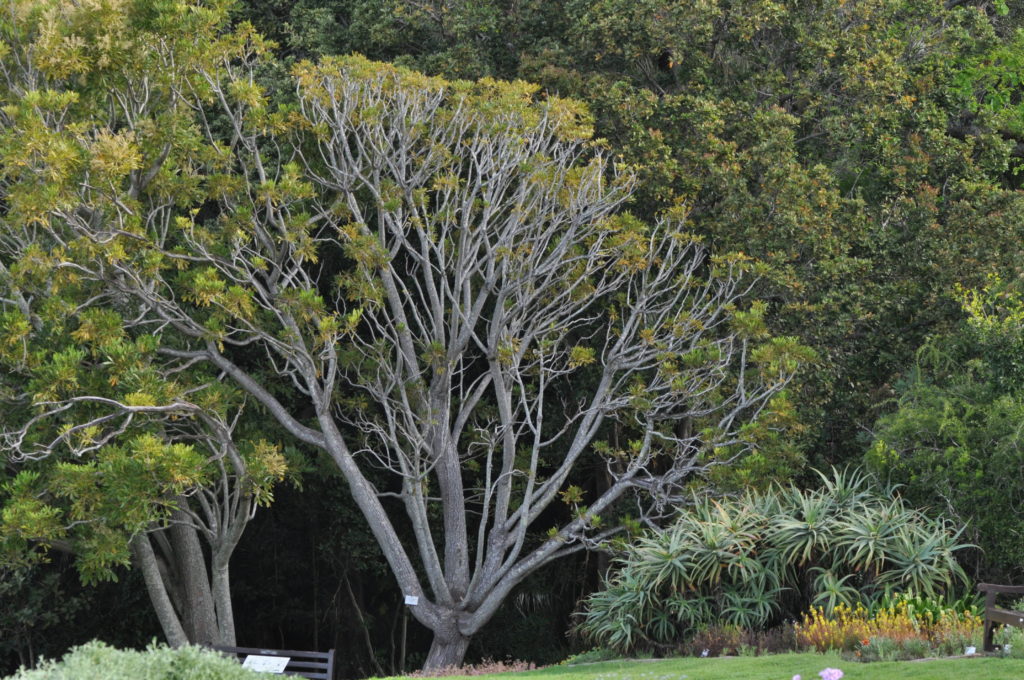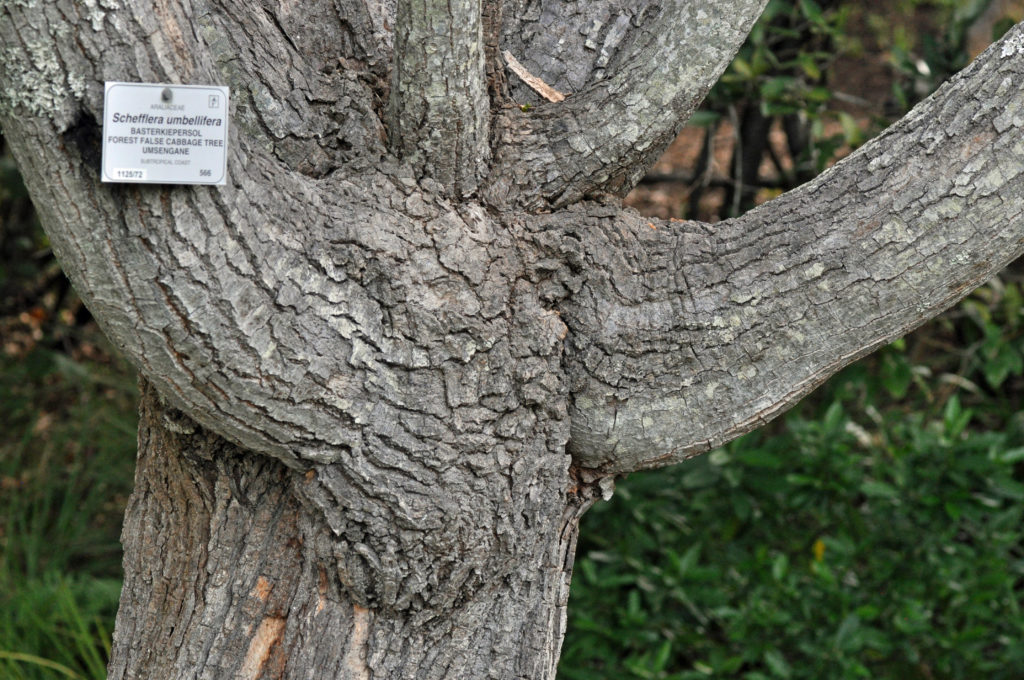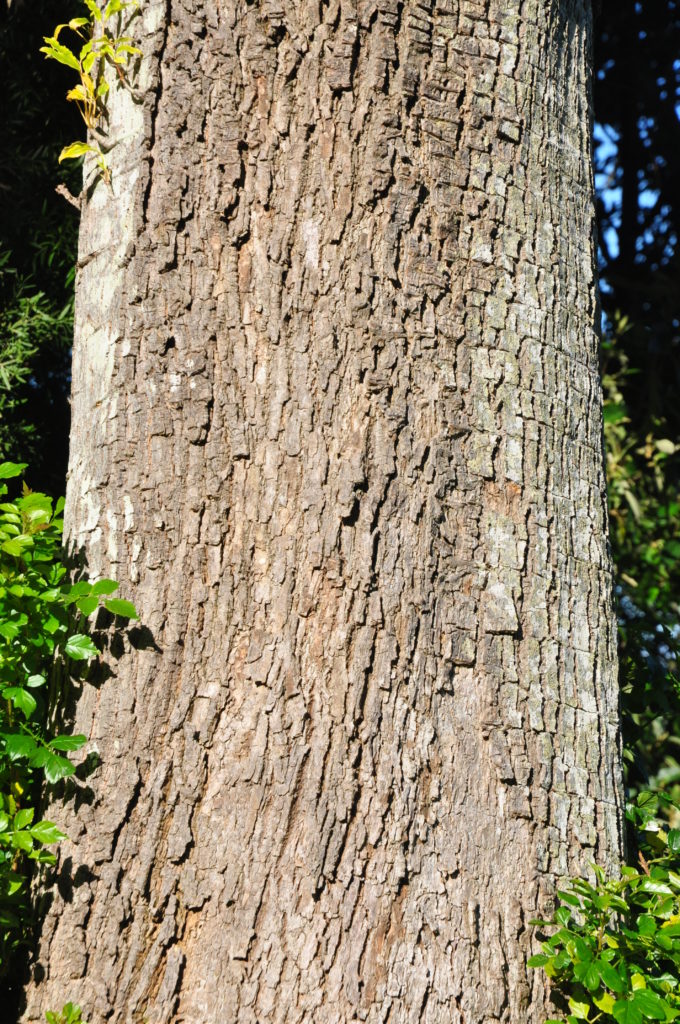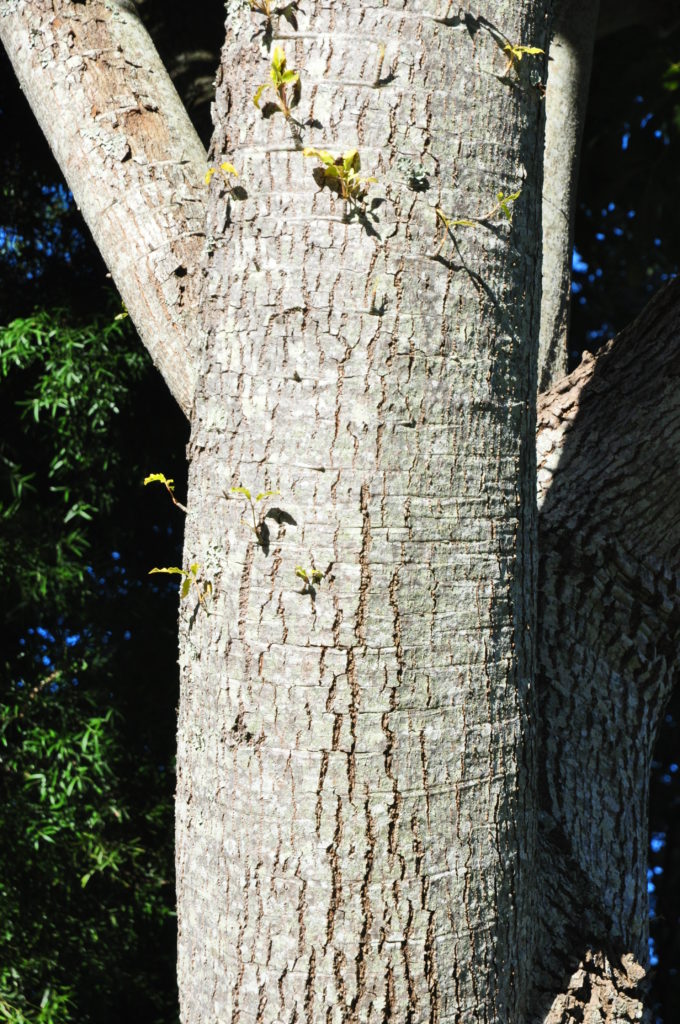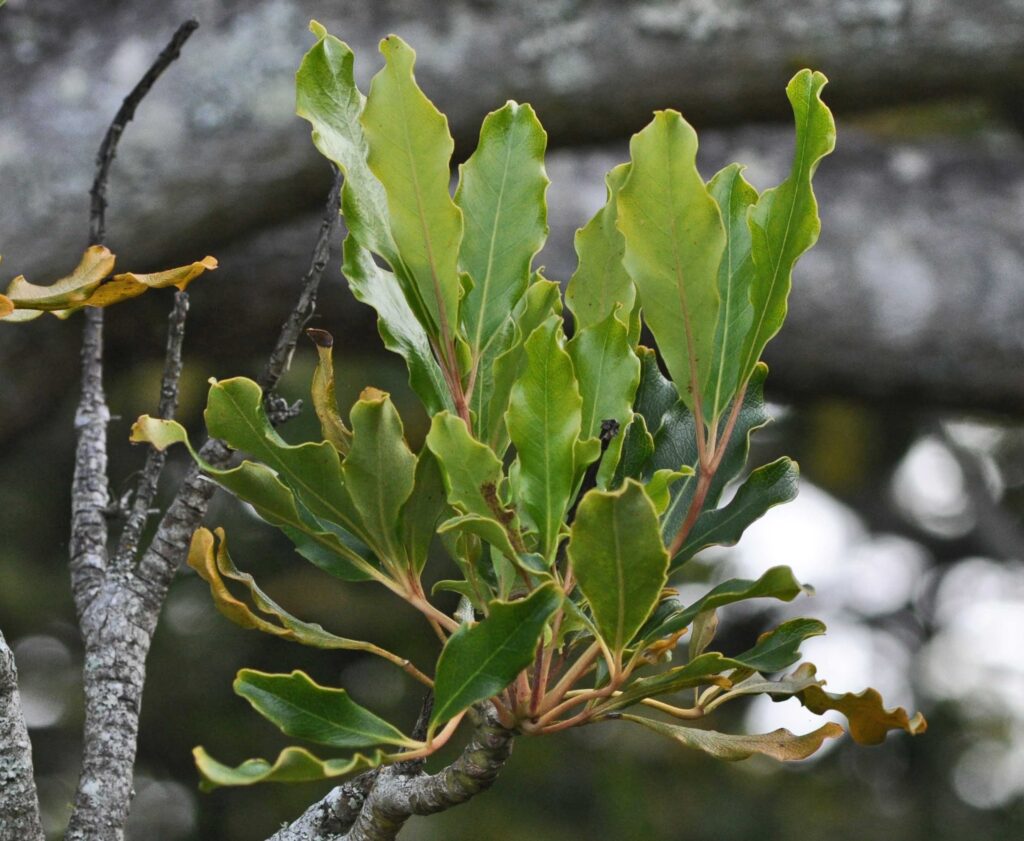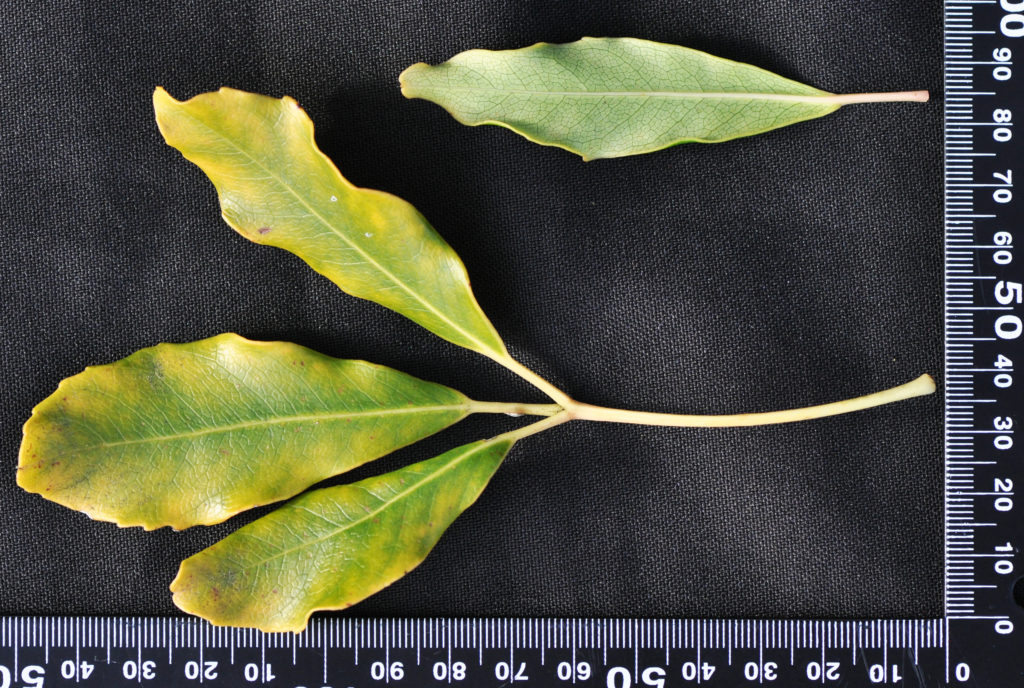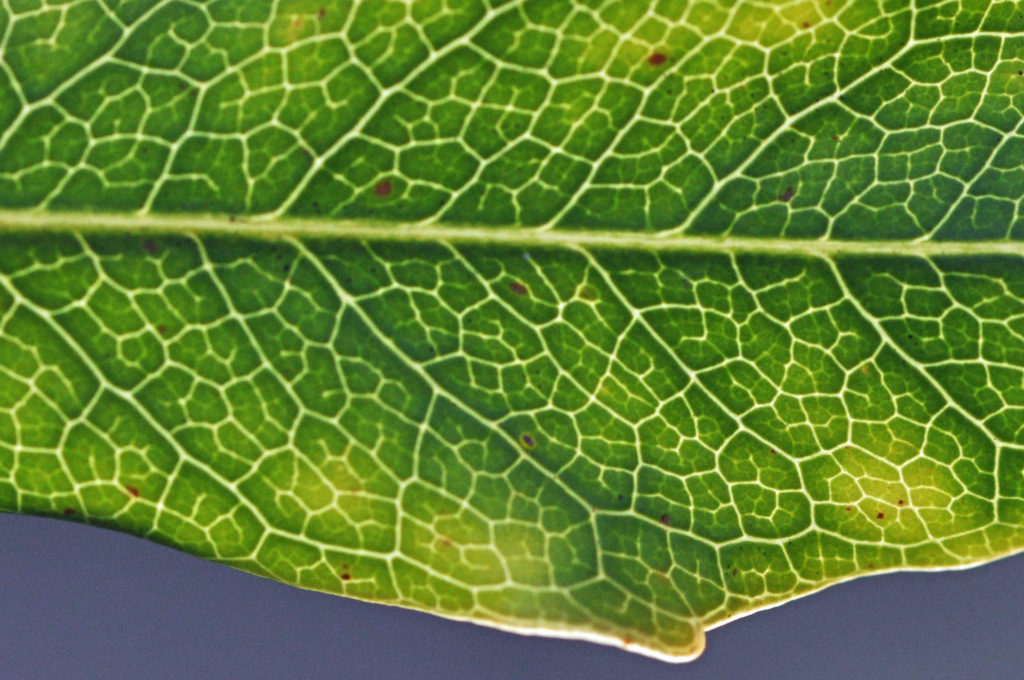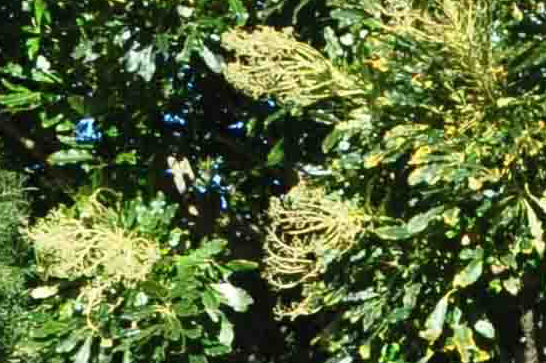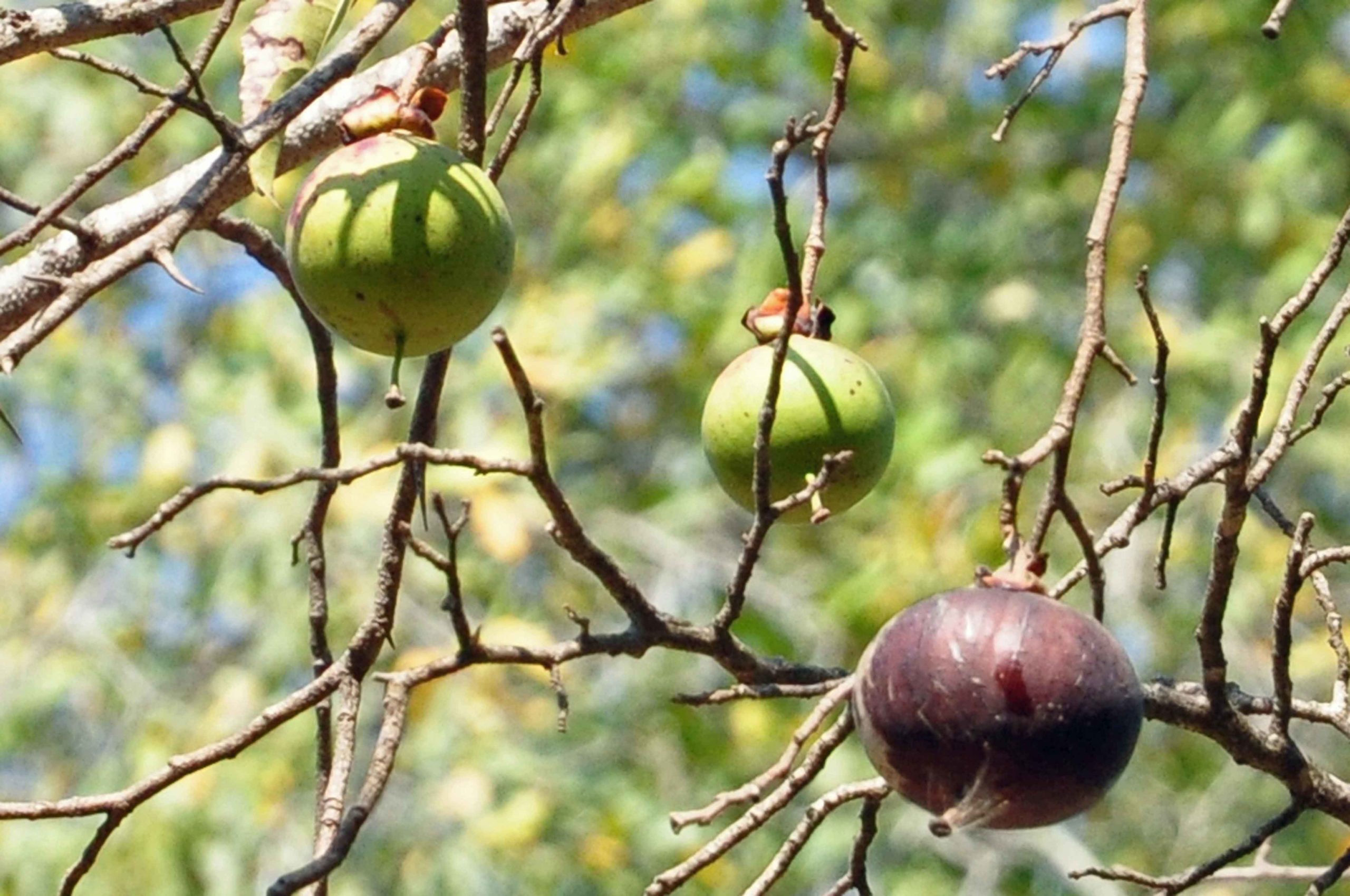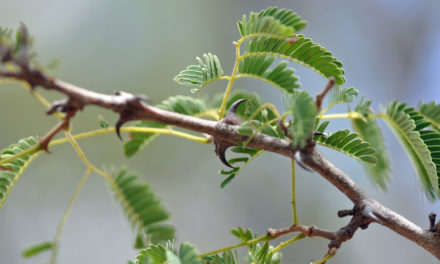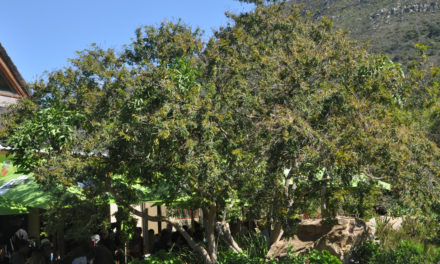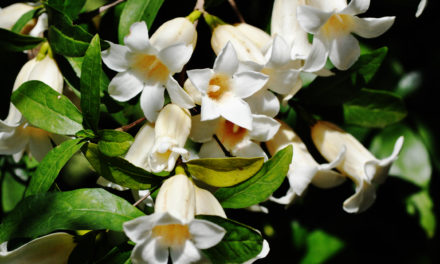General Info – summary
This Tree has grey-brown bark, is up to 20m high and a 0,6m wide trunk that may be buttressed. Seedlings have simple Leaves. Mature leaves are palmately compound with 3-5 wavy leaflets. The many small, whitish, regular and 5-merous Flowers in a large inflorescence. Anthers have 2 theca. The inferior ovary has 2 locules, 2 styles and 2 Stigmas. Fruit a small 2-locular, oval berry – ripening to a deep red.
Description
Schefflera umbellifera
Previous Names: Cussonia chartacea, Cussonia umbellifera, Neocussonia umbellifera.
SA Tree No. 566.
Common names: (Afr) Basterkiepersol, Sambreelboom, Valskiepersol. (Eng) African Schefflera, False Cabbage-tree. (isiXhosa) Umgezisa, Umkisiso, Umrongo, Umsenge, Umsengane, Umsengembuzi. (isiZulu) Umbegele, Umbumbu, Umgezisa, Unsenge Umsengembuzi. (Northern Sotho) Mosetshe, Motshetshepudi. (Ronga) (spoken just south of Maputo in Mozambique and slightly into South Africa) Uquemaquemani. (siSwati) Umsengembuti. (Tshivenda) Mukho.
Family Araliaceae: (Ivy and cabbage-tree family). The family includes trees, shrubs, vines and herbs. The mainly woody species are of tropical distribution. In southern Africa, there are 5 genera and about 18 species. Those genera with trees on this website include Cussonia and Schefflera. Leaves are usually alternate. They may also be once or twice digitally compound. 1-3 bracts that persist around the fruit, subtend the regular, bisexual or unisexual Flowers. In Cussonia the flowers are in spikes or racemes and in Schefflera flowers are umbels, in panicles. The Calyx is often reduced. There are usually as many Stamens as Petals. Anthers are ovate or oblong with 2 pollen sacs. The usually 5 petals are attached to the inferior, 2-locular Ovary. Each locule has a single ovule. Styles equal the number of locules. The often-fleshy Fruit is usually a drupe or berry. It may split into individual carpel units, called mericarps, with 1 or more seeds.
Name derivation: Schefflera. J. R. and G Forster named the genus in 1776 in honour of Johann Peter Ernst Schefflera, an 18th century Polish botanist and physician born in 1739. umbellifera refers to the arrangement of the flowers in umbels (inflorescences in which flower stalks arise from a common point). Schefflera umbellifera is the only species of the genus Schefflera in southern Africa.
Conservation: National Status: L C (Least Concern). Assessed: 2005 (W. Foden and L. Potter).
Tree
This tall, semi-deciduous, relatively straight Tree may reach 20m high. It either has large spreading branches (photo 36) or is unbranched lower down (photo 184). The Trunk may reach 0,6m wide and may terminate in a much-branched, broad, rounded crown (photo 184). The trunk initially has relatively smooth grey-brown Bark (photo 185). Young branches have visible long lenticels (usually raised corky oval or elongated areas on the plant that allows the uncontrolled interchange of gases with the environment). The brittle Branches are smooth and mottled. With ageing, longitudinal fissures appear between which the bark may form longitudinal rectangles (photo 34). In older trees, the base may be buttressed.
- 184. 2018/09/10. Kirstenbosch. Photo: David Becking.
- 36. 2018/09/15. Kirstenbosch. Photo: David Becking.
- 34. 2015/09/15. Kirstenbosch. Photo: David Becking.
- 186. 2018/09/10. Kirstenbosch NBG. Photo: David Becking.
- 185. 2018/09/10. Kirstenbosch NBG. Photo: David Becking.
Leaves
Seedlings have leaves that are simple (have a single blade which may have incisions that are not deep enough to divide the leaf into leaflets). The mature, shiny dark green and leathery Leaves are crowded at the ends of branches (photo 35) and may reach 25+cm long. They are spirally arranged and palmately compound (digitately compound leaves that are lobed or divided or ribbed in a palm-like or hand-like fashion with all leaflets arising from a single point – photo 39). Individual Leaflets are ovate, oblong or lance shaped and may reach 15 x 5cm. The Blade is dark green and glossy above and lighter on the lower surface. The Petiole (leaf stalk) is up to 20cm long and may be red. The 3 to 5 leaflets are attached by Petiolules (leaflet stalks) which are up to 4cm long (photo 39). Stipules (basal appendage of the petiole) are absent. The Midrib is raised on the lower leaf surface and here the Veins may be hairy. Vein details are best observed against a strong light (photo 40). Here a hand lens will help. The Apex is round, tapering, broadly pointed or notched. The leaflet Margins may be toothed on the upper half and leaves are usually distinctly wavy (photo 35). The Base tapers.
- 35. 2018/09/15. Kirstenbosch. Photo: David Becking.
- 39. 2018/09/15. Kirstenbosch. Photo: David Becking.
- 40. 2018/09/15. Kirstenbosch. Photo: David Becking.
Flowers
This tree is conspicuous when in Flower. The small straw-coloured flowers are in a Panicles (indeterminate, branched inflorescence with stalked flowers) or Umbels (inflorescence in which flower stalks arise from a common point). These large inflorescences are up to 18cm wide and extend above the leaves (photo 184E). Individual, bisexual flowers are yellowish white and stand on a Pedicel (stalk of a single flower) that is up to 4cm long. Flowers are Actinomorphic (Regular, symmetrical. Flowers are vertically divisible into similar halves by more than 1 plane passing through the axis). The 5-merous flowers (flower parts in 5’s) have 5 Sepals in the Calyx. They are indistinctly toothed and valvate (meeting by the edge without overlapping). The Corolla has 5 greenish cream to yellowish Petals. The 5 Stamens have Anthers that are 2-thecus (with 2 pollen sacs). The Disc (a more or less fleshy or elevated development of the receptacle) has a wavy margin. The inferior Ovary has 2 locules (chambers within an ovary) and 2 Styles (structures supporting the 2 Stigmas – the parts of the pistil that receives the pollen). (Jan-May).
- 184E 2018.09.10 Kirstenbosch. Photo: David Becking.
Fruit
The oval, fleshy Fruit is small – up to 4mm wide. It is a 2 locular Berry (pulpy, indehiscent fruit like a grape or tomato), which is greyish green and matures to a deep red/purple colour. (Jun-Aug).
Distribution & Ecology
This tree is generally found in and around warm and moist forests – usually ranging away from the coast to an altitude of 1 800m – often on mountain slopes. It is mild frost tolerant. Trees are less common on grassy hills. Trees may be solitary or in groups. Specific locations include the Eastern Cape, Kwazulu-Natal (where it is common in swamp forests), Limpopo, Mpumalanga as well as Swaziland, Lesotho, Mozambique, Zimbabwe and Malawi. Insects pollinate the flowers. Birds consume the fruit and are responsible for seed dispersal.
Ethnobotany
The Wood has a low density. It is soft, white and more solid than that of the Cussonia. It is used for carving, fruit boxes and was once used for matchmaking. Leaves and Bark are used in local medicine. Seeds are difficult to germinate (take up to 6 weeks) and are difficult to grow. However, this is a good garden tree. Transplanted seedlings do best. Roots are invasive – keep clear of buildings. Young trees should be protected from frost and trees do best in areas that are not excessively dry. A plant extract has shown some antiplasmodial (anti-malarial) activity. Local medicine makes use of the leaves.
References
Boon, R. 2010. Pooley’s Trees of eastern South Africa. Flora and Fauna Publications Trust, Durban.
Burrows, J.E., Burrows, S.M., Lotter, M.C. & Schmidt, E. 2018. Trees and Shrubs Mozambique. Publishing Print Matters (Pty) Ltd. Noordhoek, Cape Town.
Coates Palgrave, M. 2002. Keith Coates Palgrave Trees of Southern Africa, edn 3. Struik, Cape Town.
Foden, W. & Potter, L. 2005. Schefflera umbellifera (Sond.) Baill. National Assessment: Red List of South African Plants version 2020.1. Accessed on 2023/11/22.
Palmer, E. & Pitman, N. 1972. Trees of southern Africa. Balkema, Amsterdam, Cape Town.
Schmidt, S. Lotter, M. & McCleland, W. 2002. Trees and Shrubs of Mpumalanga and the Kruger National Park. Jacana, Johannesburg.
van Wyk, B. & van Wyk, P. 1997 Field guide to Trees of Southern Africa. Struik, Cape Town.
http://eol.org/pages/32352/overview
https://en.wikipedia.org/wiki/Schefflera_umbellifera
http://www.greenplanet.co.za/plant/Schefflera-umbellifera
http://posa.sanbi.org/flora/browse.php?src=SP
Schefflera umbellifera | PlantZAfrica (sanbi.org)

